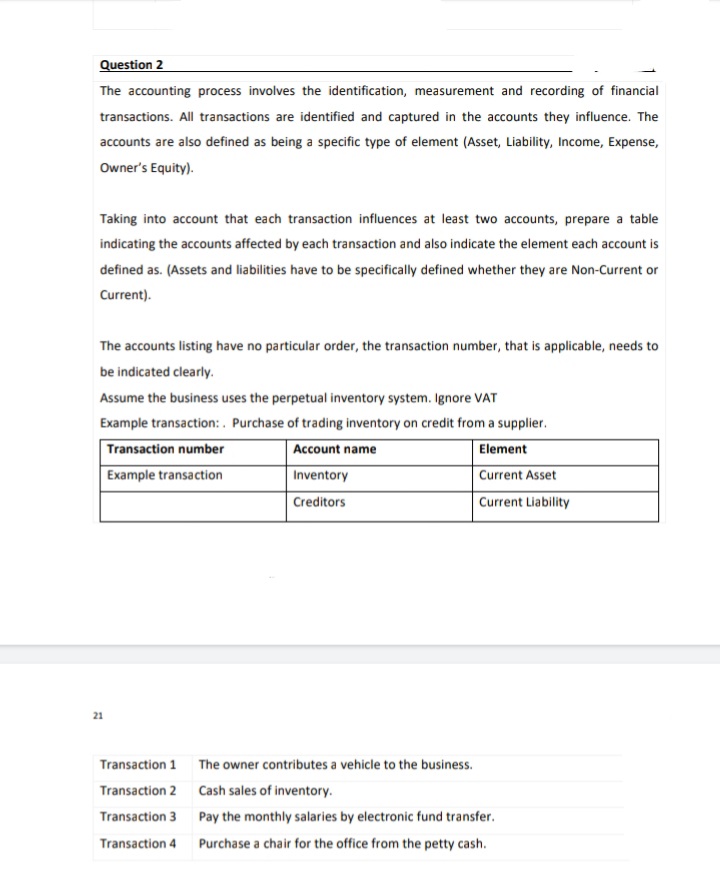Question 2 The accounting process involves the identification, measurement and recording of financial transactions. All transactions are identified and captured in the accounts they influence. The accounts are also defined as being a specific type of element (Asset, Liability, Income, Expense, Owner's Equity). Taking into account that each transaction influences at least two accounts, prepare a table indicating the accounts affected by each transaction and also indicate the element each account is defined as. (Assets and liabilities have to be specifically defined whether they are Non-Current or Current). The accounts listing have no particular order, the transaction number, that is applicable, needs to be indicated clearly. Assume the business uses the perpetual inventory system. Ignore VAT Example transaction: . Purchase of trading inventory on credit from a supplier. Transaction number Account name Element Example transaction Inventory Current Asset Creditors Current Liability 21 Transaction 1 The owner contributes a vehicle to the business. Transaction 2 Cash sales of inventory. Transaction 3 Pay the monthly salaries by electronic fund transfer. Transaction 4 Purchase a chair for the office from the petty cash.
Question 2 The accounting process involves the identification, measurement and recording of financial transactions. All transactions are identified and captured in the accounts they influence. The accounts are also defined as being a specific type of element (Asset, Liability, Income, Expense, Owner's Equity). Taking into account that each transaction influences at least two accounts, prepare a table indicating the accounts affected by each transaction and also indicate the element each account is defined as. (Assets and liabilities have to be specifically defined whether they are Non-Current or Current). The accounts listing have no particular order, the transaction number, that is applicable, needs to be indicated clearly. Assume the business uses the perpetual inventory system. Ignore VAT Example transaction: . Purchase of trading inventory on credit from a supplier. Transaction number Account name Element Example transaction Inventory Current Asset Creditors Current Liability 21 Transaction 1 The owner contributes a vehicle to the business. Transaction 2 Cash sales of inventory. Transaction 3 Pay the monthly salaries by electronic fund transfer. Transaction 4 Purchase a chair for the office from the petty cash.
Auditing: A Risk Based-Approach (MindTap Course List)
11th Edition
ISBN:9781337619455
Author:Karla M Johnstone, Audrey A. Gramling, Larry E. Rittenberg
Publisher:Karla M Johnstone, Audrey A. Gramling, Larry E. Rittenberg
Chapter11: Auditing Inventory, Goods And Services, And Accounts Payable: The Acquisition And Payment Cycle
Section: Chapter Questions
Problem 4RQSC
Related questions
Question

Transcribed Image Text:Question 2
The accounting process involves the identification, measurement and recording of financial
transactions. All transactions are identified and captured in the accounts they influence. The
accounts are also defined as being a specific type of element (Asset, Liability, Income, Expense,
Owner's Equity).
Taking into account that each transaction influences at least two accounts, prepare a table
indicating the accounts affected by each transaction and also indicate the element each account is
defined as. (Assets and liabilities have to be specifically defined whether they are Non-Current or
Current).
The accounts listing have no particular order, the transaction number, that is applicable, needs to
be indicated clearly.
Assume the business uses the perpetual inventory system. Ignore VAT
Example transaction: . Purchase of trading inventory on credit from a supplier.
Transaction number
Account name
Element
Example transaction
Inventory
Current Asset
Creditors
Current Liability
21
Transaction 1 The owner contributes a vehicle to the business.
Transaction 2 Cash sales of inventory.
Transaction 3 Pay the monthly salaries by electronic fund transfer.
Transaction 4 Purchase a chair for the office from the petty cash.
Expert Solution
This question has been solved!
Explore an expertly crafted, step-by-step solution for a thorough understanding of key concepts.
Step by step
Solved in 2 steps

Knowledge Booster
Learn more about
Need a deep-dive on the concept behind this application? Look no further. Learn more about this topic, accounting and related others by exploring similar questions and additional content below.Recommended textbooks for you

Auditing: A Risk Based-Approach (MindTap Course L…
Accounting
ISBN:
9781337619455
Author:
Karla M Johnstone, Audrey A. Gramling, Larry E. Rittenberg
Publisher:
Cengage Learning

Corporate Financial Accounting
Accounting
ISBN:
9781305653535
Author:
Carl Warren, James M. Reeve, Jonathan Duchac
Publisher:
Cengage Learning

Financial Accounting: The Impact on Decision Make…
Accounting
ISBN:
9781305654174
Author:
Gary A. Porter, Curtis L. Norton
Publisher:
Cengage Learning

Auditing: A Risk Based-Approach (MindTap Course L…
Accounting
ISBN:
9781337619455
Author:
Karla M Johnstone, Audrey A. Gramling, Larry E. Rittenberg
Publisher:
Cengage Learning

Corporate Financial Accounting
Accounting
ISBN:
9781305653535
Author:
Carl Warren, James M. Reeve, Jonathan Duchac
Publisher:
Cengage Learning

Financial Accounting: The Impact on Decision Make…
Accounting
ISBN:
9781305654174
Author:
Gary A. Porter, Curtis L. Norton
Publisher:
Cengage Learning

Cornerstones of Financial Accounting
Accounting
ISBN:
9781337690881
Author:
Jay Rich, Jeff Jones
Publisher:
Cengage Learning

College Accounting, Chapters 1-27
Accounting
ISBN:
9781337794756
Author:
HEINTZ, James A.
Publisher:
Cengage Learning,

College Accounting (Book Only): A Career Approach
Accounting
ISBN:
9781337280570
Author:
Scott, Cathy J.
Publisher:
South-Western College Pub